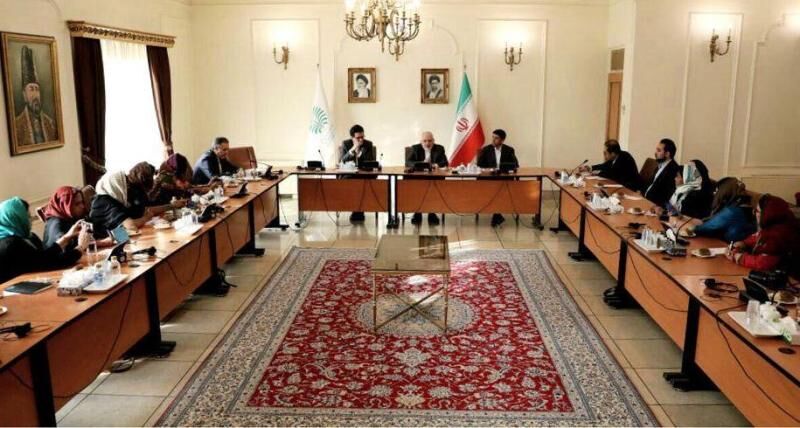
Iran’s Foreign Minister Mohammed Javad Zarif received a group of Indian writers and journalists, Tehran, Nov 10, 2019
Historically speaking, India-Iran relationship had its ups and downs during the decades under Shah’s rule. The Lowest point was reached when during the 1965 and 1971 wars with India, Pakistani Air Force jets were stationed in Iran to gain ‘strategic depth’ vis-a-vis the IAF.
However, after the 1979 Islamic revolution, Iran adopted an explicitly anti-Western foreign policy and began viewing India as a natural ally. The ideology-based regime rooted in the principles of justice, freedom and resistance was greatly attracted by India’s freedom struggle, non-aligned policies, and the sheer grit to preserve its strategic autonomy. This perceived affinity withstood the changes and shifts in Delhi’s foreign policy outlook in the post-Cold war era.
Tehran was not unduly perturbed when India-US relationship took an upward curve in the nineties during the Bill Clinton administration or when the 2008 nuclear deal was concluded — or, even when Washington and Delhi began chanting their ‘defining partnership of the 21st century’ during the Barack Obama Administration.
Tehran remained confident about India’s DNA anchored on the country’s strategic autonomy. This confidence took a beating when India voted for the first time in February 2006 in favour of a West-led resolution in the International Atomic Energy Agency (IAEA), which reported against Iran to the UN Security Council — and, again, in November 2009 when India voted in favour of a resolution spearheaded by the US at the IAEA censuring Tehran over its controversial nuclear programme and demanding that it stop uranium enrichment.
Nonetheless, life moved on. There was no apparent rancour. This much needs to be recalled to put in perspective the highly critical remarks by Iran’s foreign minister Mohammad Javad Zarif recently, while meeting a group of visiting journalists from New Delhi, regarding the Modi government’s pusillanimous attitude under American pressure to roll back cooperation with Tehran.
Zarif said Tehran had expected Modi government to be “more resilient” in the face of Washington’s bullying. Zarif speculated that India probably “did not want to agitate” the US by being a sanctions spoiler and he added with biting sarcasm, “People want to be on the right side of President Trump” but the problem is “he hasn’t got a right side.”
Equally, Zarif regretted that Modi government was dragging its feet on the Chabahar Port project, which has far-reaching implications for regional connectivity, stability and security.
The Iranian state media widely reported Zarif’s remarks, which most certainly reflect the deep misgivings at the highest level of Iranian leadership that India’s capacity or political will to pursue independent foreign policies is increasingly in doubt.
To be sure, Zarif’s remarks must also be seen in the backdrop of the Modi government’s fawning attitude toward Saudi Arabia lately. There is no empirical evidence to suggest that Riyadh laid pre-conditions for Crown Prince Mohammed bin Salman’s embrace of PM Modi. In fact, Saudi-Iranian rivalry is far too complex to be reduced to zero-sum mindset. After all, Riyadh is robustly advancing cooperation with Russia and China despite these two countries having thriving strategic partnerships with Iran.
Indian analysts tend to link the Modi government’s dalliance with Saudi Arabia and the deepening chill in Indian-Iranian relations. Indeed, the Modi government has relegated cooperation with Iran to the back burner. It is no secret of course that Washington encourages third countries to replace Iranian crude with Saudi supplies.
Modi government is pinning hopes on massive Saudi investments in India. During the Crown Prince’s visit to India in February, he forecast Saudi investments to the tune of $100 billion during the next two-year period. The Indian side has been daydreaming since then about big Saudi investments in the Ratnagiri petrochemical project and in the Reliance Industries. While Ratnagiri project is in limbo, Reliance is keeping its fingers crossed. Modi’s recent visit to Saudi Arabia can be viewed in this context.
How realistic are the Indian expectations? Clearly, Saudi Arabia itself needs to attract outside investment. Lackluster oil prices have caused the country’s budget deficit to widen. The budget deficit would be in the region of $36 billion in 2018 and 2019, and may widen to $50 billion in 2020. Saudi Aramco’s IPO itself is for raising money for funding the Crown Prince’s ambitious program of economic and social reforms (‘Vision 2030’).
The CNBC had recently featured an interview with the ex-CIA chief General David Petraeus (who presently heads the KKR Global Institute, which provides consultancy to American companies active in the Middle East) regarding Saudi Arabia’s economic malaise. Some excerpts are worth noting:
“It’s a fact that Saudi Arabia is gradually running out of money, they’d be the first to acknowledge that the sovereign wealth fund has been reduced, it’s somewhere below $500 billion now.”
“The (budget) deficits each year, depending on the price of Brent crude, can be anywhere from $40 to $60 billion depending on some of their activities in countries in the region.”
“The bottom line is that they need the money, they need that outside investment that is crucial to delivering ‘Vision 2030’ which cannot be realized without outside investment, this is just one component of a number of different initiatives that they’re pursuing to try to attract that outside investment.”
The prospects aren’t bright for Reliance and Ratnagiri to pin hopes on Saudi investment. The Crown Prince’s priority is ‘Vision 2030’ — and it remains a hard sell. Period.
Put differently, neglecting India’s cooperation with Iran, especially Chabahar Port development, for the sake of a chimerical Saudi bonanza can only find the Modi government falling between two stools eventually. India cannot, should not and need not substitute Saudi Arabia as a preferred partner to Iran — or vice versa.
Why keep at arm’s length a regional power in our extended neighbourhood who is manifestly eager to foster cooperation with India? Such attitude is illogical, myopic and cramps India’s diplomatic options in the Persian Gulf.
